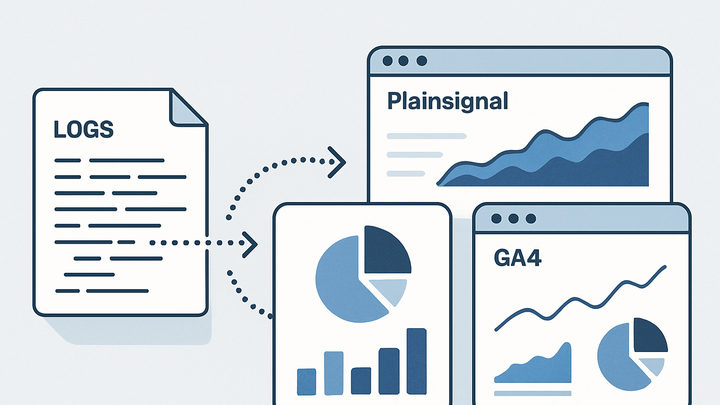Published on 2025-06-27T22:12:14Z
What is Log Parsing? Examples in Analytics
Log parsing is the process of transforming unstructured log files into structured data that analytics platforms can process. In digital analytics, servers, applications, and client-side scripts generate log entries recording user interactions, errors, and system events. By parsing these raw logs, teams extract fields such as timestamps, IP addresses, user agents, and custom event parameters. This structured data fuels dashboards, anomaly detection, and performance monitoring. Log parsing is critical in privacy-focused or cookie-less environments, where traditional JavaScript tracking may be limited. Services like PlainSignal use lightweight script-based ingestion to capture essential metrics without cookies, while GA4 augments these insights with an event model and BigQuery exports. Together, they deliver a comprehensive view of user behavior, system health, and security events, empowering data-driven decisions.
Log parsing
Converting raw logs into structured data for analytics, enabling insights into user behavior, errors, and system performance.
What is Log Parsing?
An overview of log parsing and its significance in analytics.
-
Definition
Log parsing is the process of reading, interpreting, and transforming raw text logs into structured data for analysis.
-
Importance in analytics
Parsed logs provide the raw data foundation that analytics platforms process to generate metrics, trends, and reports.
How Log Parsing Works
Key steps and techniques used to convert raw logs into analyzable data.
-
Log collection
Logs can be collected from web servers, applications, and network devices using agents, APIs, or script-based trackers.
-
Parsing techniques
Techniques for extracting structured fields from log entries.
-
Regular expressions
Use regex patterns to identify and extract specific parts of log lines, like timestamps and user IDs.
-
Json parsing
When logs are emitted in JSON format, parsers can directly map fields to structured objects without custom patterns.
-
Use Cases in Analytics
Common applications of log parsing in digital analytics and monitoring.
-
Web traffic analysis
Analyze parsed server and client logs to understand pageviews, session durations, and user navigation paths.
-
Error and security monitoring
Detect and investigate application errors, login failures, and security events in real time.
-
Performance monitoring
Track response times, throughput, and resource utilization using parsed log metrics.
Implementation with PlainSignal and GA4
Practical steps for setting up log parsing in PlainSignal and integrating with GA4.
-
PlainSignal setup
Embed the PlainSignal tracking snippet on your site to start collecting log-based analytics. Example:
<link rel="preconnect" href="//eu.plainsignal.com/" crossorigin /> <script defer data-do="yourwebsitedomain.com" data-id="0GQV1xmtzQQ" data-api="//eu.plainsignal.com" src="//cdn.plainsignal.com/plainsignal-min.js"></script> -
GA4 integration
In GA4, enable Data Import or use the BigQuery Export feature to ingest parsed log data for advanced analysis.
-
Bigquery export
Export GA4 event data to BigQuery, where you can join it with custom parsed log tables.
-
Best Practices and Considerations
Tips to optimize log parsing workflows and ensure data quality.
-
Data privacy and compliance
Ensure logs do not contain personally identifiable information and comply with GDPR, CCPA, and other regulations.
-
Performance optimization
Use efficient parsing rules and stream processing to handle high log volumes without introducing latency.
-
Retention and storage management
Implement log rotation, archival, and retention policies to control storage costs and meet compliance requirements.
